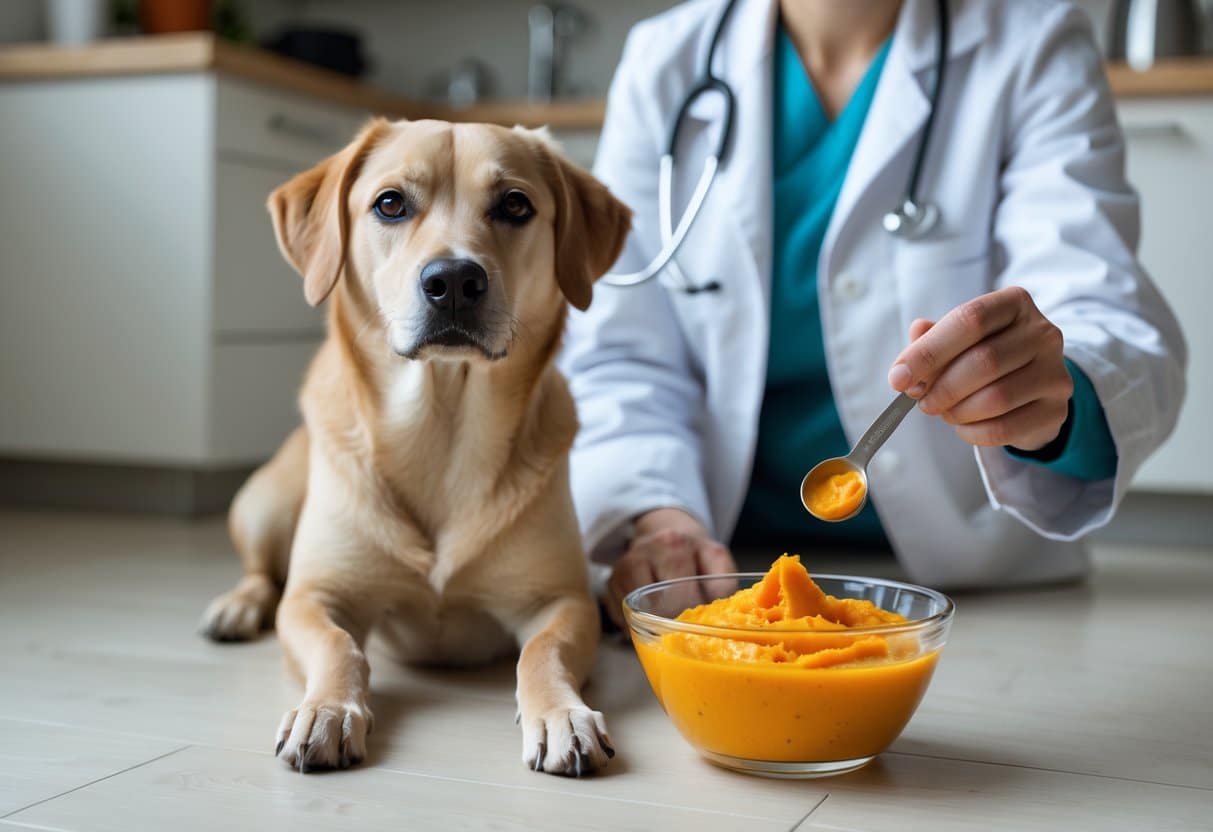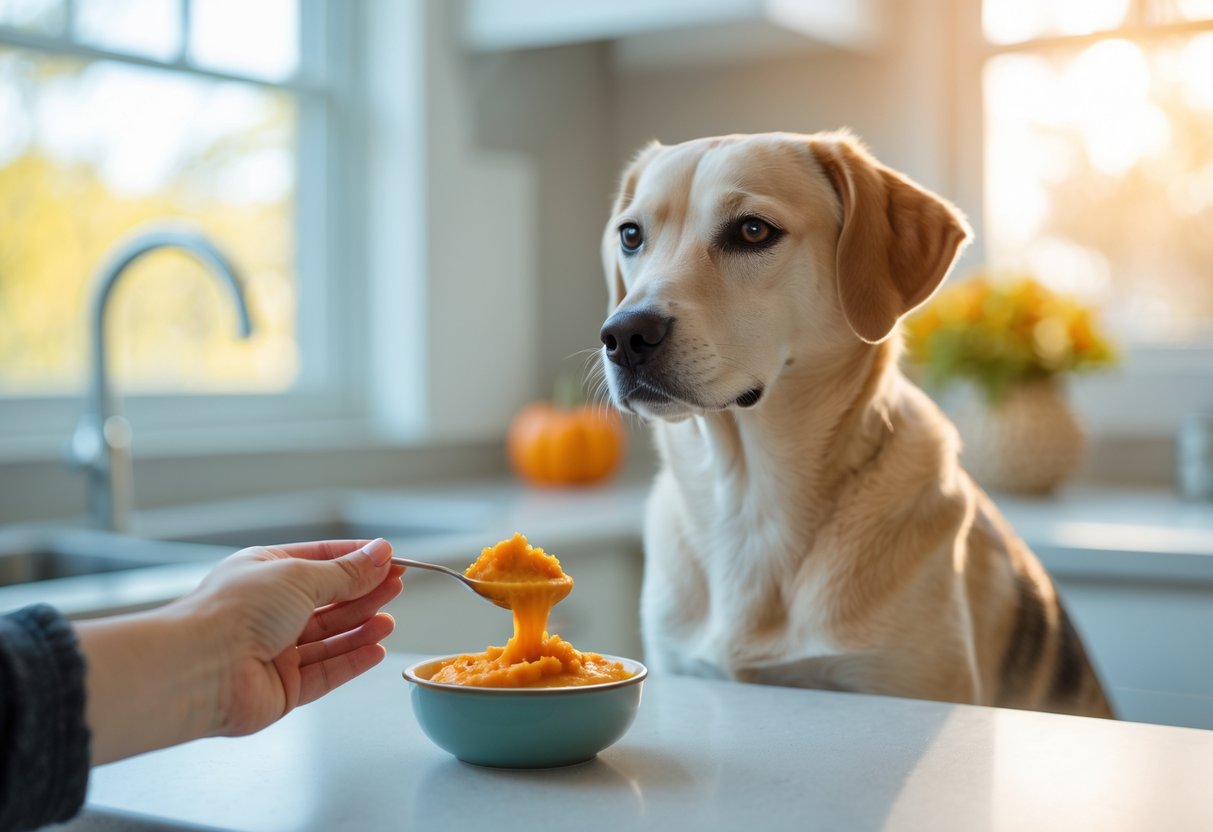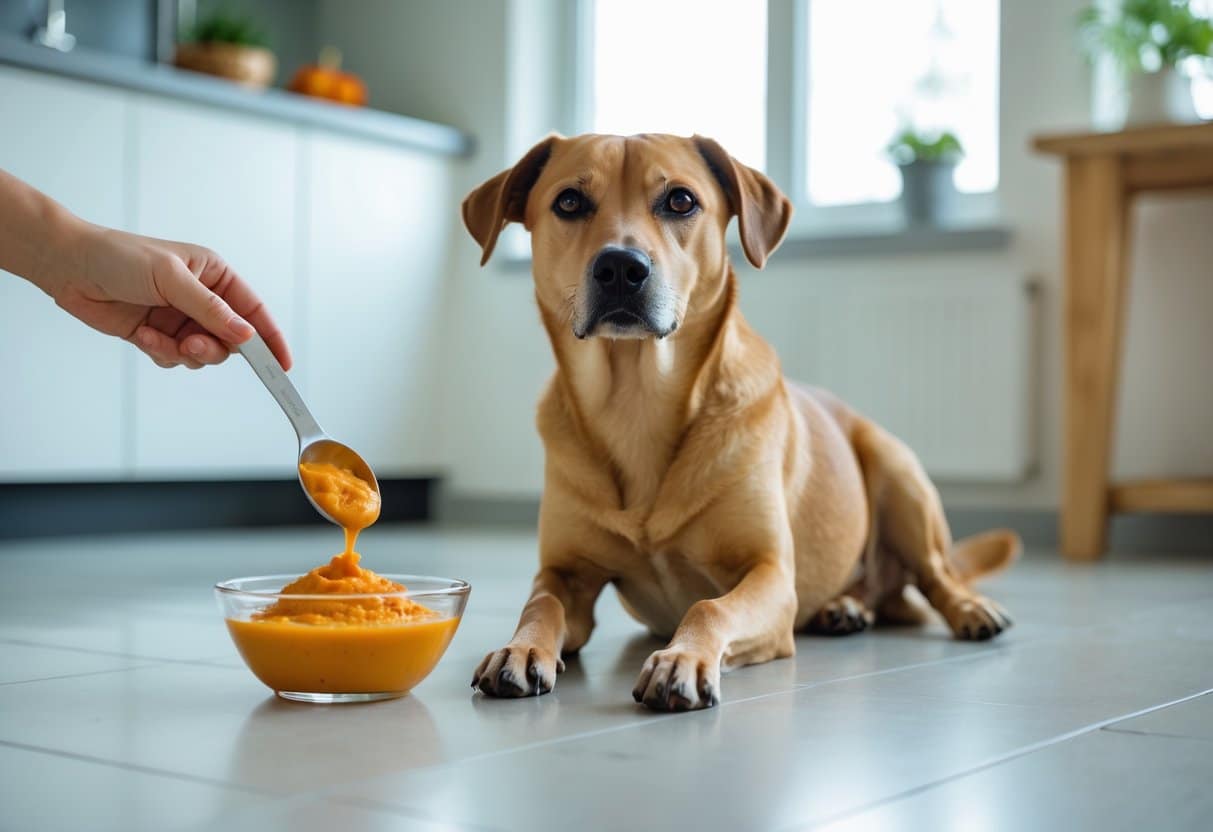
When a dog gets diarrhea, a lot of pet owners start hunting for safe home remedies to help their pup bounce back. Pumpkin puree has really caught on as a go-to natural fix, and honestly, many vets are on board with it for digestive problems in dogs.
For dogs with diarrhea, give 1 teaspoon of plain pumpkin puree per 10 pounds of body weight per meal. Small dogs get about 1-4 tablespoons daily, and bigger breeds can handle up to 1/2 cup per day.
The fiber-rich pumpkin helps firm up loose stools and supports digestion without harsh meds. But, you really do need to get the amount right—too much or the wrong kind can actually backfire and make tummy troubles worse.
Key Takeaways
- Give 1 teaspoon of plain pumpkin puree per 10 pounds of body weight per meal for dogs with diarrhea
- Only use plain canned pumpkin puree, never pumpkin pie filling which contains harmful spices and sugars
- Contact a veterinarian if diarrhea persists beyond 48 hours or if the dog shows other concerning symptoms
Recommended Pumpkin Puree Dosage for Dogs With Diarrhea

How much pumpkin you give really depends on your dog’s weight and size. Small dogs usually need just 1-2 tablespoons daily, while those big, lovable goofballs might need up to half a cup.
It’s best to start with a smaller amount and see how your dog reacts. That way, you won’t accidentally cause more digestive drama (no one wants that mess).
General Guidelines by Weight and Size
Pet experts recommend 1 teaspoon per 10 pounds of body weight as a safe starting point. It’s a simple formula and makes the math easy for any dog.
Most dogs do fine with pumpkin puree once or twice a day, mixed in with their food. The fiber in pumpkin usually helps tighten things up within a day or two.
Weight-Based Dosing:
- 10 lbs: 1 teaspoon
- 20 lbs: 2 teaspoons
- 30 lbs: 3 teaspoons (1 tablespoon)
- 50 lbs: 5 teaspoons
- 70+ lbs: 7+ teaspoons
Always stick to plain canned pumpkin puree. Pumpkin pie filling is a no-go—spices and sugar can make things worse in a hurry.
Dosage for Small, Medium, and Large Breeds
Dogs under 25 pounds just need 1-2 tablespoons of pumpkin puree daily for diarrhea. That’s usually plenty of fiber for their smaller systems.
Medium-sized pups (25-60 pounds) can handle 2-4 tablespoons per day. It’s a good idea to split that between breakfast and dinner for better absorption.
Large breeds, over 60 pounds, may need up to half a cup daily. Their size means they need more to get the digestive benefits.
Daily Amounts by Size:
- Small breeds: 1-2 tablespoons
- Medium breeds: 2-4 tablespoons
- Large breeds: 4-8 tablespoons (up to 1/2 cup)
How to Safely Increase or Decrease the Amount
Start with the lowest recommended dose for your dog’s size. Too much fiber all at once can lead to constipation or some pretty spectacular gas—ask me how I know.
If the runs stick around, bump up the pumpkin slowly over a couple of days. Add an extra teaspoon every other day, but don’t go wild with it.
Keep an eye out for signs you’ve overdone it—constipation, gas, or an uncomfortable pup. If you see those, cut the amount by half and see if things settle down.
Once your dog’s poop looks normal again, you can stop the pumpkin. Pumpkin works best as a short-term fix, not something you add every day forever.
If diarrhea hangs on for more than two or three days, even with pumpkin, it’s time to call your vet. Ongoing symptoms can mean there’s something more serious going on.
Why Pumpkin Puree Helps Dogs With Diarrhea
Pumpkin puree is popular for a reason: its high fiber content helps firm up loose stools and gives a boost to good gut bacteria. It’s a gentle alternative to prescription meds for mild tummy upsets.
High Fiber Content and Stool Firming
Pumpkin contains soluble fiber that absorbs excess water in the gut, helping to firm up your dog’s poop. This fiber bulks things up in the intestines.
When mixed with water, the soluble fiber forms a gel-like substance. That slows digestion down and gives the colon more time to soak up water from waste.
Key benefits of pumpkin’s fiber content:
- Absorbs extra liquid in the digestive tract
- Makes stools firmer and more formed
- Helps keep bowel movements regular
- Offers gentle relief—no harsh chemicals needed
Lots of dogs start feeling better within 12 to 24 hours of eating pumpkin. The fiber works with the body, not against it.
Role of Prebiotics and Gut Health
Pumpkin puree doubles as a prebiotic, feeding the good bacteria in your dog’s gut. Those friendly microbes are crucial for healthy digestion and fighting off nastier bugs.
When a dog has diarrhea, their gut bacteria can get knocked out of balance. The prebiotic fiber in pumpkin helps restore that balance—sort of like pressing a reset button.
It encourages the growth of Lactobacillus and Bifidobacterium strains that support digestive health.
How prebiotics in pumpkin help:
- Nourish beneficial gut bacteria
- Help restore a balanced microbiome
- Boost nutrient absorption
- Strengthen the gut lining
This natural approach does more than just patch up symptoms. It can help prevent future stomach issues, too.
Natural Remedy vs. Prescription Options
Pumpkin is a gentle, natural option for mild dog diarrhea. Lots of pet owners would rather try something natural before jumping to meds.
Prescription anti-diarrheals can have side effects or even lead to dependence. Pumpkin rarely causes problems if you stick to the right amount.
Comparison of treatment options:
| Treatment Type | Speed | Side Effects | Cost |
|---|---|---|---|
| Pumpkin puree | 12-24 hours | Minimal | Low |
| Prescription drugs | 2-6 hours | Possible | Higher |
| Bland diet | 24-48 hours | None | Moderate |
Pumpkin is best for mild cases. If your dog has severe diarrhea, blood in the stool, or symptoms that last longer than two days, get your vet involved.
Choosing the Right Type of Pumpkin Puree
The type of pumpkin puree you pick honestly matters more than you’d think. Plain, unsweetened pumpkin is what you want—anything with extra ingredients can mess up your dog’s stomach even more.
Plain Versus Canned Pumpkin Puree
Canned pumpkin puree is super convenient and you know what you’re getting every time. Most vets recommend canned because it’s consistent and easy to use.
Look for labels that say “100% pumpkin” or “pure pumpkin.” That’s the stuff—just cooked and pureed pumpkin flesh, nothing weird added.
Homemade pumpkin puree works, too. If you’re feeling ambitious, roast up a sugar pumpkin or pie pumpkin and blend it smooth.
The main difference? Prep time and storage. Canned keeps forever, while homemade needs to be eaten or refrigerated within a few days.
Both options give your dog the same digestive benefits. The fiber content is about the same, whether it’s canned or homemade, so go with whatever fits your routine.
Importance of Unsweetened Pumpkin
Unsweetened pumpkin puree is really the only safe pick for dogs with tummy troubles. Sugary versions? Those can make diarrhea worse and just upset your dog’s stomach even more.
Sugar feeds the wrong bacteria in your dog’s gut. That can drag out diarrhea and open the door to more health headaches you just don’t want.
Natural pumpkin has a gentle sweetness on its own—most dogs like it as is. The fiber and nutrients are most effective when you skip the sweeteners.
Unsweetened pumpkin is great for firming up loose stools because of its high fiber. If you toss in extra sugars, you lose that benefit.
Always check those ingredient lists. Some cans say “pumpkin” but sneak in corn syrup, sugar, or weird artificial stuff.
Avoiding Additives and Pumpkin Pie Filling
Pumpkin pie filling isn’t safe for dogs with diarrhea. It often contains dangerous extras like spices, sugar, and preservatives that just make things worse.
Watch out for these common additives:
- Cinnamon and nutmeg
- Sugar and corn syrup
- Xanthan gum
- Artificial flavoring
- Salt
Plain pumpkin puree without harmful additives is the safest way to go. All you want is pumpkin flesh and water, nothing else.
Nutmeg, for example, can actually be toxic for dogs if they get too much. Even a pinch might irritate a sensitive stomach.
Reading the label literally takes a few seconds and can save you a lot of stress. Look for ingredient lists that just say “pumpkin.”
How to Feed Pumpkin Puree to Your Dog
The trick with pumpkin puree is to mix it in slowly and watch how your dog reacts. Start with a tiny amount stirred into their usual food and keep an eye on things.
Best Methods for Mixing Pumpkin With Food
Direct mixing is usually the easiest. Just scoop the right amount of plain pumpkin puree into your dog’s food—kibble or wet—and stir it up well.
You can also make a paste by blending pumpkin with a splash of warm water. This is especially nice for dogs with sensitive stomachs.
Or, if you’re into prepping ahead, freeze portions in ice cube trays. Each cube is about a tablespoon—handy for quick serving.
| Method | Best For | Instructions |
|---|---|---|
| Direct mixing | Most dogs | Stir 1-4 tablespoons into regular food |
| Paste method | Sensitive stomachs | Mix with warm water before adding |
| Frozen cubes | Portion control | Freeze in ice cube trays |
Don’t mix pumpkin with dairy or high-fat foods if your dog’s stomach is already upset. That combo rarely ends well. feeding pumpkin to dogs
Starting Slowly and Monitoring Reactions
Begin with half the recommended dose for the first couple days. Let your dog’s system get used to it.
Check for changes in stool within 12 to 24 hours. Dogs with diarrhea sometimes improve pretty quickly.
Good signs are firmer poop and fewer trips outside. If your dog’s eating and acting normal, that’s a win.
Bad signs? Vomiting, lots of gas, or diarrhea getting worse. If you see any of that, stop the pumpkin right away.
If things look good, slowly work up to the full amount. Most dogs handle it fine after about a week.
When to Use Caution or See a Veterinarian

Pumpkin helps a lot of dogs with diarrhea, but sometimes you need to get the vet involved right away. Too much pumpkin can also cause its own problems.
Warning Signs in Dogs With Diarrhea
Major symptoms mean it’s time for emergency care. Blood in the stool? That’s a red flag for something serious.
If your dog is vomiting and has diarrhea, they can get dangerously dehydrated fast. Weakness can set in within hours.
Lethargy and weakness usually mean your dog is losing too much fluid. Some dogs won’t eat or drink at all when they’re really sick.
Fever over 103°F is another sign things aren’t right. High temps can actually do organ damage if you wait too long.
Dehydration shows up as dry gums, sunken eyes, or skin that doesn’t bounce back when pinched. Puppies and seniors are especially at risk.
If diarrhea lasts more than a day or two, call your vet. Chronic cases require veterinary care rather than home remedies.
Health Conditions That Require Extra Care
Diabetic dogs need careful blood sugar checks with new foods. Even pumpkin’s natural sugar can make a difference.
Kidney disease means watching certain nutrients. Those dogs can’t process waste like healthy pups do.
Puppies under 12 weeks have very delicate guts. Their systems are still figuring things out.
Older dogs on lots of meds can get weird reactions from new foods. Sometimes it messes with their prescriptions.
Inflammatory bowel disease is tricky. Adding fiber without a vet’s say-so can set off a flare-up.
Dogs just out of surgery need their food managed with care. Sudden changes can upset their healing digestive system.
Pancreatitis patients should avoid certain foods altogether. Even healthy stuff like pumpkin can sometimes trigger pain.
Potential Side Effects of Excess Pumpkin
Too much pumpkin can flip diarrhea into constipation. That fiber works both ways if you overdo it.
Big servings might cause stomach aches or gas. Some dogs end up with cramps or feel bloated.
Mix-ups happen when people use pumpkin pie filling instead of plain puree. Those spices and sugars can really mess things up.
Giving dogs too much pumpkin puree leads to gastrointestinal upset—think vomiting or ongoing diarrhea.
Weight gain sneaks up if you feed pumpkin all the time. It does have calories, after all.
And yeah, some dogs get orange-tinged poop from all that beta-carotene. It’s harmless, but definitely a sign you’re giving too much.
Additional Supportive Care and Prevention
Keeping your dog hydrated and managing their diet are huge for recovery. A few easy habits can help avoid future stomach disasters, too.
Hydration and Bland Diet Recommendations
Diarrhea drains dogs of water and electrolytes. Make sure fresh water is always out and encourage them to drink as much as possible.
Tips for water intake:
- Keep water bowls topped up all day
- Add a splash of low-sodium chicken broth for picky drinkers
- Watch for dry gums or sluggishness—classic dehydration signs
A bland diet goes a long way. It gives the gut a break while pumpkin does its thing. Stick to easy foods that won’t cause more irritation.
Good bland diet choices:
- Plain white rice (cooked, cooled)
- Boiled chicken breast (no skin, no seasoning)
- Plain sweet potato (cooked and mashed)
- Bone broth (low sodium, no onions or garlic)
Serve smaller meals more often instead of big portions. It’s easier on the stomach and helps nutrients absorb better.
Preventing Future Digestive Issues
Consistency is the secret to a happy dog gut. Sudden food switches are behind a lot of diarrhea cases—change things slowly over a week or so.
Feed your dog at the same times every day. It helps keep their digestion on track, like clockwork.
Other prevention tips:
- Skip table scraps and people food
- Keep trash cans closed and out of reach
- Watch your dog outside—no eating random stuff
- Stay up to date on parasite prevention
Honestly, stress can mess with digestion, too. Big life changes or a busy household sometimes throw sensitive dogs off.
Probiotics made for dogs can help long-term gut health. They keep the good bacteria in balance and might cut down on future problems.
Frequently Asked Questions
People have a lot of questions about pumpkin puree, dosing, and what to expect. The right amount depends on your dog’s size, and you usually see results within a day or two.
How much pumpkin puree is safe for a dog with diarrhea?
The safe amount of pumpkin for dogs is 1 teaspoon per 10 pounds of body weight per meal. For diarrhea, most dogs do well with 1-4 teaspoons of plain pumpkin puree per meal.
Small dogs: 1-2 teaspoons per meal. Medium dogs: 2-3 teaspoons per meal.
Large dogs can go up to a tablespoon per meal. It’s smart to start small and see how your dog handles it.
What are the benefits of giving pumpkin to a dog with an upset stomach?
Pumpkin’s fiber helps firm up loose stools by soaking up extra water in the gut. It’s a gentle way to get things back on track.
It also packs important nutrients like potassium, vitamin A, and beta-carotene. All good for overall digestive health.
Natural pumpkin supports regular bowel movements and can even help with constipation or anal gland issues. Pumpkin can help with constipation, anal gland issues, and overall gut health in dogs.
Is canned pumpkin suitable for dogs with digestive issues?
Plain canned pumpkin is generally safe and pretty effective for dogs with digestive problems. Just be sure you’re picking pure pumpkin puree—no sneaky added ingredients.
Pumpkin pie filling? That’s a no-go. It usually has spices and sugars that can actually make digestive issues worse.
Check those labels closely to make sure the can says only pumpkin. Plain canned pumpkin is high in fiber, which can help firm up stools in pets.
Honestly, canned is way easier than roasting and mashing fresh pumpkin every time.
What is the appropriate serving size of pumpkin puree for a dog with constipation?
If your dog’s constipated, the dosing is about the same as for diarrhea. The fiber in pumpkin works both ways to help regulate things.
Try giving 1 teaspoon per 10 pounds of body weight per meal. Keep an eye on your pup for the next day or two to see how they’re doing.
Don’t forget to bump up their water intake when you add pumpkin. Fiber needs enough hydration to do its job.
Can too much pumpkin exacerbate a dog’s diarrhea?
Too much pumpkin? Yeah, that can backfire and cause stomach upset or even constipation. Giving dogs too much pumpkin can lead to constipation or stomach upset.
All that extra fiber can overwhelm their digestive system, and sometimes dogs get gassy or bloated when they first try pumpkin.
Start small, see how your dog handles it, and only increase if they seem fine with it. No need to rush things.
How quickly does pumpkin puree typically alleviate symptoms of diarrhea in dogs?
Most dogs start feeling better within 24 to 48 hours after getting some pumpkin puree. Pet experts report that improvement should be visible within this timeframe.
Some pups bounce back even sooner, while others might need the full two days. Sticking to a regular dose seems to help, at least in my experience.
If your dog’s diarrhea is still hanging on after 48 hours, it’s probably time to give your vet a call. Pumpkin can help with mild tummy troubles, but it’s not a fix for everything.




